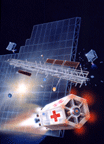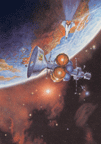|
|
|
|
|
|
|
 |
|
 |
|
|
|
| Space Art II ooo Space Art III |
|
| Click on a picture for a larger view (NOTE: some pictures may not have enlarged views at this time). |
|
|
|
Bussard Ramjet -- Science Digest, May 1983, illustrating my article on the then-current situation in interstellar studies. In 1960 Dr. Robert Bussard theorized that spacecraft fuel could be gathered up en route using strong magnetic fields. In 1983 he sat in my living room and sketched up this design, which features a multilayer forward scattershield, habitat modules, radiator tower, and ramscoop engine. The ship is seen dropping off its unmanned deuterium fusion booster after reaching 1000 kilometers per second velocity. |
|
 |
|
|
 |
Hubble Space Telescope -- Science Digest, Astronomy, and Sky & Telescope all featured this painting of the HST done as a collaboration between myself and Don Dixon. Extensive use of airbrush and acrylics, a similar rendering style, and detailed CAD drawings from Lockheed Sunnyvale allowed us to produce this orbital view a few years before Hubble was launched. Ironically, we sold an exclusive package of reproduction rights to Perkin-Elmer, the company which fabricated the faulty main mirror. |
|
 |
Sailing to Mars -- Analog, 1975. A large multinational team (long before ISS) produced a pair of solar-sailing ships which have just reached Mars. The space-built habitat of one ship, at the tail end of its tether, is visible in the foreground, while the entirety of the other solar sail ship is seen passing Phobos. |
|
 |
Space Doctor -- Novel by G. Harry Stine writing as Lee Correy, Del Rey Books. An ambulance module tears away from an orbital worksite accident in this story of the dangers of space construction. In the 1970s, some imaged that large space-based solar arrays would be beaming cheap energy to Earth by now. Located at GEO 22,500 miles up, orbiting medical facilities would be required along with habitats; it is assumed that returning to Earth might take too long or the g-load could prove more harmful to the patient than staying in microgravity. |
|
 |
Caloris Basin Impact -- Analog January 1981. Cover illustrating the article "Mercury's Missing Divot," theorizing that the impacting object which formed Caloris pretty well exploded outward and disappeared. Not sure if that's true or if I recall the premise correctly, but the craters were fun to do, mostly with a Paasche AB turbo airbrush, the only airbrush that sounds like a dentist's drill and has nine adjustments to keep straight, or else forget about it giving a nice even spray. |
|
|
Laser Light Sail -- Science Digest, May 1983. As part of the starships article depicting a concept by the late Dr. Robert Forward, this shows a landing vehicle about to perform a descent maneuver in a distant solar system, having left the giant aluminized sail in the distance. The scale is deceiving; this is only the central 2/3 of a sail whose total diameter is some 1000 miles. The outer ring has traveled beyond the planet to act as a laser "brake" for the inner parts. The small center section will return to Earth using the middle section as a laser reflector. Hard to keep track of it all, but I always tried not to question Dr. Bob's wisdom. |
|
|
 |
|
 |
Tricentennial -- Analog, July 1976. Joe Haldeman won the Hugo for this short story, and I won for Best Pro Artist, so we did a bit of celebrating, as one can imagine. I finished the art for editor Ben Bova before Joe finished writing, so Joe had to work in some bits about a smacked drive reflector and a lost EVA repair pod, plainly visible in the illustration. The poor starship couldn't slow down until it had reached a spot near the North American Nebula, circa 2076. The funny thing is that previously, Ben had gently turned down the idea of Joe and myself collaborating on a story/cover package. "Those things never work out," he said. A year later, early in 1976, Ben had this great idea, you see, about me and Joe working together. I'd say it all worked out pretty nicely. Thanks, Ben. |
|
|
 |
|
|
|
|
All artwork and descriptions ©2003 Rick Sternbach. See Copyright page for more information on rights and permissions. |
|
|
|
|
|
|
|
|
|
|
|
|
|
|
|













